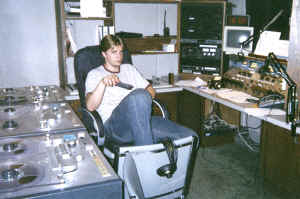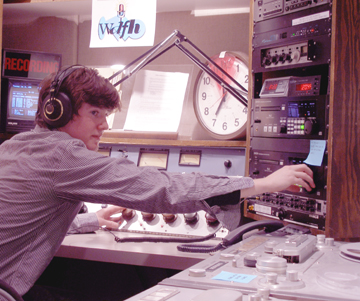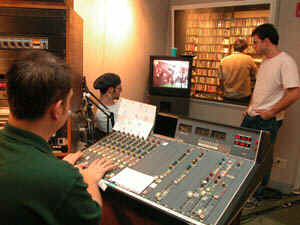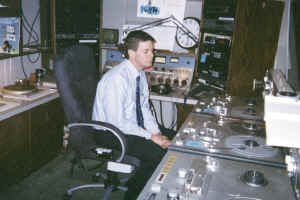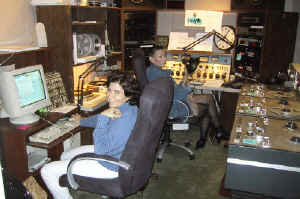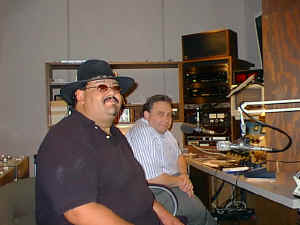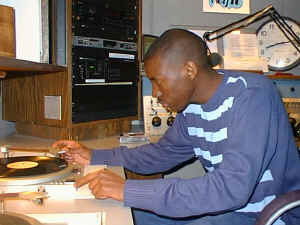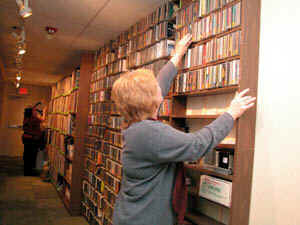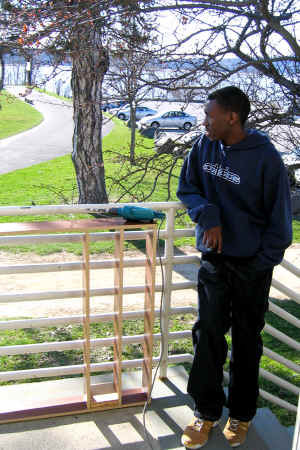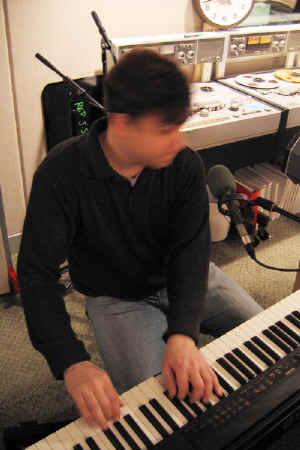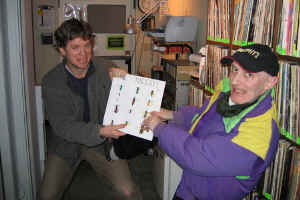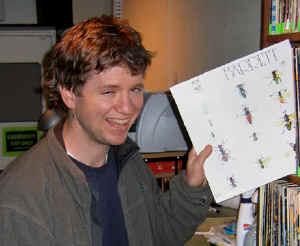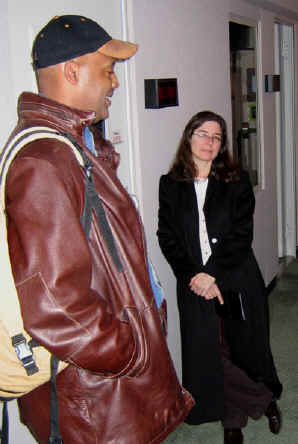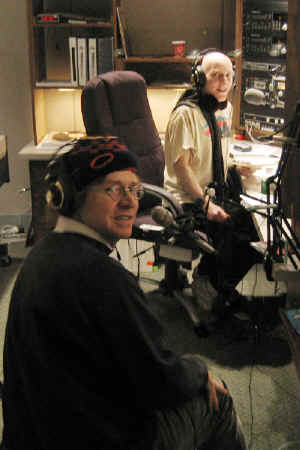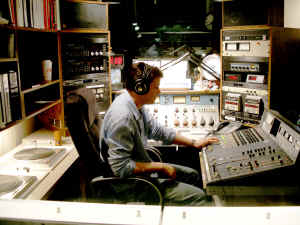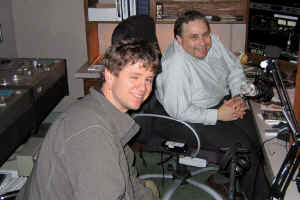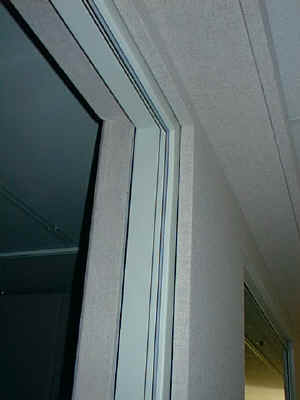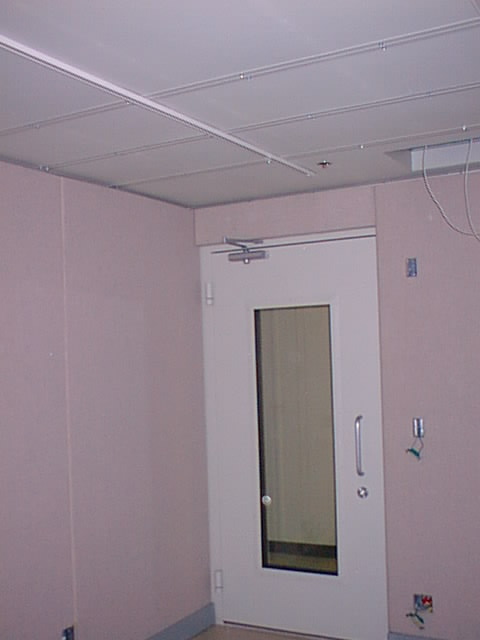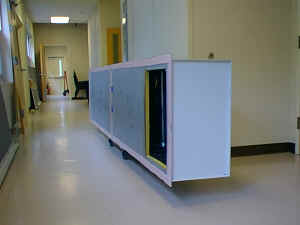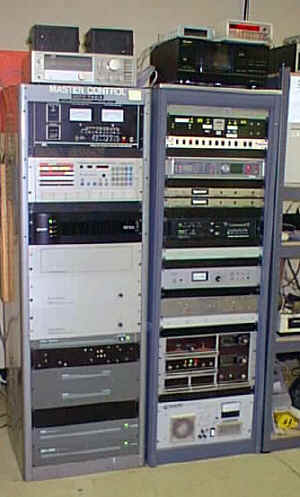|
WDFH is licensed by the FCC as a noncommercial educational Class A (full service) FM radio station and broadcasts on 90.3 MHz (FM channel 212A). We are an independent community radio station. Our community of license is Ossining, New York. In February 2009, we completed a major expansion our signal and can now be heard in central and northern Westchester, southern Putnam, and eastern Rockland counties in New York as well as in parts of western Connecticut. More on the signal project >>
Our new antenna is 160 feet above ground on a tower built on a 630 foot hill — so our antenna elevation is nearly two thirds the height of the Empire State Building. With FM transmission, height is of key importance, so even with modest power, WDFH is comparable to considerably more powerful stations in other parts of the country in terms of population served — which, of course, is what really matters. (For example, KCSU, Colorado State University, 10,000 watts, population served 250,000; KXUL, University of Louisiana at Monroe, 8500 watts, population served 212,000; WICB, Ithaca College, 5500 watts, population served 150,000.) WDFH broadcasts 24 hours a day, 365 days a year in stereo. (We used to run an RDS subcarrier at 57 kHz but there's a lack of consumer interest so it is not currently on.) We put a lot of emphasis on maintaining a high quality audio signal that respects the artistic musical quality of our programming, so we take a very light-handed approach to on-the-air audio processing — leading one of our listeners (a network television engineer) to call WDFH "an aural delight in lightly processed stereo."
For more than 20 years, WDFH operated in extremely quaint, cute, increasingly technically sophisticated but crowded studios in the upstairs attic rooms of Marc's parents' Tudor-style house in Dobbs Ferry (photos 1982-1993, photos 1982 and earlier), first as a Part 15 station and then as a cable station. (Part 15 of the FCC rules allow extremely low power unlicensed broadcasting that reaches a very small service area.) But the goal was always to get an FM license, and in the mid 1990s, the FCC granted our application. This meant moving out of the house up to Ossining and finding a place there to build new studios. This is where the miserable part of the saga begins; we ended up in a decrepit office building on Croton Avenue in Ossining. We transformed two small, run-down rooms into attractive if crowded studios. But as described elsewhere on this website, this tenancy rapidly developed into a nightmarish landlord situation in which, after just 15 months on the air, we were forced to leave the building in 1996. In the end, we had to remove everything we had put in — all the soundproofing, lighting, carpeting, acoustic double walls, equipment, furniture, record and CD libraries, even our tower and transmitter. (The ghostly image of that tower is in the photo behind the navigation links at the left side of the pages here at wdfh.org.) Everything went into storage as we scrambled to find new locations for the studios and the transmitter. This was undoubtedly the most depressing time in the almost 30 year history of the station, and WDFH was off the air for nearly a year. We found a new location for the transmitter and went back on the air in 1997. In 2000 we formed an alliance with a local college and built a new studio complex there. After protracted delays by the college, we were finally able to start broadcasting from the new studios in September 2003. Less than a year later, the college ran into serious financial problems, and the alliance with WDFH ended in 2006. In connection with our first broadcast from the new facilities, we had a series of grand opening events a month later (some pictures are shown below). We've accomplished a lot since then as we've developed the station — we barnraised a satellite dish, affiliated with the Pacifica Radio Network, and added two daily newsmagazines to our schedule (Democracy Now! and Free Speech Radio News). We covered the political conventions in Boston and New York with credentialed reporters inside the convention centers and history, government, and political science professors from the college as expert commentators. We aired extensive political coverage during the fall of 2004, including the presidential and vice-presidential debates as well as debates among candidates for mayor of Ossining. Meanwhile, we took on student interns, had musicians visit for live studio performances about once a month, launched new local public affairs programs (In Focus and Recovery Talk), produced a powerful three hour program commemorating the third anniversary of the September 11 attacks... and the list goes on. So now, a look inside this beautiful facility and some of the dedicated people who somehow manage to find some space in their busy New York metro lives to come together and contribute their time, talents, and energy to make all this possible — bringing WDFH — our dreams, our hopes, our potentialities — to life.
WDFH's Studio Facilities As we have noted elsewhere, WDFH had its most recent studios in Dobbs Ferry, but we lost the space in 2006. Following is a description of the studios we built and have now vacated: There are three full control rooms and a newsroom/news production studio, as well as two offices and a long hallway that serves as a sound lock and also houses our music library (see floorplan). The facilities are still under construction; Studios 2 and 3 are completed and Studio 1 and the newsroom will be constructed soon. We use a healthy mix of traditional technologies (reel-to-reel, DAT, CDs, turntables) and newer digital editing and multitrack production on a networked computer system. This gives us a choice of production methods for anything from live on-air programming to complex multi-layer documentaries. We use well maintained vintage RCA audio consoles, but they are past their prime and we plan to replace them. (See Soundcraft counsole, above right. We also have a Pacific Recorders BMX console. Another community radio station donated two Harrison consoles and NPR donated two Wheatstone consoles.) Speaking as we were a moment ago of live on-air programming, we are proudly a throwback to an earlier age: all music is played from records and CDs. There are lots of options for stations that want to play music off a hard drive, but we believe that there's something organic and exciting that happens when a DJ can go into the stacks, see some cover art on an album, and get inspired to take a program in a new direction. Selecting songs off a menu with a mouse is sort of sterile in comparison. It's even worse when a computer program makes the decisions, which is how the music on many stations is programmed. Radio at its best can be an art form, and we're sticking with our vinyl and CDs. The studios give us the space and technical facilities to invite musical guests to the studios for interviews and live in-studio performances. Excellent acoustics and technical facilities, combined with skilled and tasteful engineering, have resulted in some beautiful stereo recordings of live performances at WDFH. At some point we plan to release a CD compilation of studio performances.
So... on to discussing the studio design. Working with an overall design by WDFH's Marc Sophos, the NYC consulting firm of Northeastern Communications Concepts provided acoustical design for the new facility. NCC has designed major broadcast facilities all over the place and is without question one of the major players in broadcast studio design. Their projects include XM Satellite Radio and, in New York, the showcase facilities of WQXR and WNYC. Now WDFH joins the proud ranks of stations with NCC-designed studios. WDFH's studios are constructed of pre-fabricated modular composite steel wall and ceiling panels, doors, and windows constructed at the Texas factory of Acoustic Systems. The pre-fabricated modular approach allows walls to be much thinner than walls employing traditional soundproofing methods, which typically require two separate sets of studs and several layers of drywall and insulation. The space saving is significant — the modular soundproof wall is only 4" thick, compared with 18" or more for traditional studio walls — and so, for a given amount of floor space, rooms can be larger. Modular walls are also lighter, an important consideration where floor loading is a concern. It's also much easier to get a high level of isolation this way because the studios are constructed in a factory, trucked to the location, and quickly installed by an experienced and factory-trained team; thus, the varying quality of workmanship of local contractors, who often don't have experience with soundproofing, is eliminated as a factor. WDFH's studios were installed in about a week. (The general contracting was another story, but that's another conversation entirely....) Each of WDFH's studios is a separate structure that sits on the concrete slab floor of the building. The walls and windows of one room have no rigid connection to the walls and windows of adjacent rooms or to any part of the main building structure aside from the floor itself. This contributes to the high level of acoustical isolation between adjacent studios. The one thing we didn't do was to install floating floors. This technique would have provided an even higher level of acoustic isolation, but we decided against it because of height limitations (we would have ended up with seven foot ceilings), significant extra cost, and ADA (Americans with Disabilities Act) considerations. Our building is relatively quiet anyway, so floating floors would likely have been overkill. Studio interiors are finished with fabric-wrapped fiberglass panels, which control the acoustics within each studio. The panels, fabricated and installed by Acoustical and Tackable Surfaces, provide better acoustic control than the cut-foam products often found in radio broadcast studios. The fabric and the underlying surface of the fiberglass provide middle and high frequency absorption. The backs of the panels are hollow, creating cavities between the panels and the wall surfaces; these cavities function as bass traps, absorbing low frequency energy. The overall effect is one of almost overwhelming silence — it seems as if any residual sound is literally sucked right out of the room, leaving a beautiful, silent background for voice and music originating at WDFH. The panels also present a highly professional and attractive appearance. Wire and cable management in the studios is handled by floor-level steel ducts that run around the interior perimeter of each room. Wire and cabling (originating at Master Control and carrying audio, control, telecommunications, and computer networking signals into each studio) run in the hallway in a specially-built trough that runs along the studio exterior walls above the doors but below the suspended ceiling. This approach enabled us to avoid the extra expense of plenum-rated cabling while keeping it all out of sight. Cables enter the rooms through concealed small holes in the walls near the ceiling, then travel down the walls behind the fiberglass panels and enter the ducts, from where they can travel anywhere in the room. This installation provides for neat, concealed wiring runs that are invisible from where they leave Master Control to where they emerge onto the terminal blocks in each studio. Neither the visual nor the acoustic integrity of the studios is compromised. There are large interior windows between each adjacent pair of studios and between most studios and the hallway. The windows are made of laminated and acoustically inert glass. They are canted and sealed in resilient neoprene. The neoprene keeps the air seal (and thus the sound seal) tight, and the canting achieves two purposes: avoiding common resonances caused when two panes of glass are parallel, and reflecting interior sounds downward so they don't reflect back into nearby microphones. The heavy interior doors, which also have large double glass windows in them, are on hydraulic closers and cam-lift hinges. The doors also feature double magnetic sealing, so that when a door is closed, there are two separate magnetic seals, and sound simply does not get through. The interior windows in all of the studios line up so that we can see from Studio 3 all the way down through the facility to Studio 1 and, on a nice day, clear across the Hudson River. The overall effect is a feeling of spaciousness that is greater than you might expect in a 1000 square foot facility. We have long-term hopes of expanding into an adjacent space and building a new music library, an expanded Master Control room, a small storage closet, a fourth broadcast control room, and a small recording studio and conference room in the expanded 2000 square foot facility. Again, this is a long-term plan and is unlikely to happen soon; nevertheless, it is part of our continuing effort to expand WDFH's service to the public, and it will happen (we hope) when it happens. The HVAC (heat, ventilation, and air conditioning) system is designed for silence. A high volume of air is moved at low velocity, eliminating airflow noise. Large internally-baffled duct silencers — something like giant car mufflers (see photo, above right) — allow air to pass through but keep sound out, eliminating any possible sound transmission from room to room through the ductwork. The system's compressor is located on the ground outside, and the fan cooling unit, which is installed in the crawlspace underneath the staff office, is installed on resilient rubber pucks. This keeps the fans from inducing vibration into the building structure. Additional protection from vibration-induced noise, from both the system fans and adjacent studios, is provided by resilient connections between the main air supply duct and the duct silencers. In operation, the system is virtually inaudible in the studios even with full cooling on the hottest summer days. When and if we expand into the second space, our plans call for a completely separate HVAC system for the new rooms, with strategic connections with motorized dampers that can connect the systems together in case one system fails. This will give us redundancy in our HVAC systems...which would have been really nice on those hot summer days last August when our system was down completely and the temperature inside the studios hovered near 100 degrees <wry grin>. Halogen track lights on dimmers are installed throughout, so there is no problem with the buzzing and electrical interference of fluorescent lights. The incandescent lighting also gives the facility a warm, comfortable, welcoming appearance. The electrical system includes isolated grounding for all circuits used for audio equipment. Circuit allocation was carefully designed to facilitate the future installation of a backup power generator. Critical equipment, including Master Control, is on uninterruptible power supplies. There is at least one level of redundancy, and often more than one level, virtually everywhere at the station (except, as noted before, the air conditioning system <sweat, sweat>) — multiple studios, multiple audio processing, multiple paths to carry the audio between the studio and the transmitter site, multiple stereo generators and exciters in our transmitter, triple-redundant transmission system remote controls, even an auxiliary audio source at the transmitter to keep something on the air if there's a blackout at the studios — and so on-air reliability at WDFH is very close to 100%. Even our web stream has redundancy: we have a main webcast server at the studio and an auxiliary server located at a remote location. And so, as a result of careful planning and engineering throughout the design and construction processes, we are proud to have built a very nicely equipped studio facility with first class acoustics and sound isolation. Now onto the details:
WDFH's Transmission Facilities Design, installation, and maintenance by Marc Sophos. We are everlastingly grateful for the continuing and wise advice and representation from our technical consultant on FCC matters, Gray Haertig of Haertig and Associates Telecommunications Consulting Engineers, Portland, Oregon; our legal counsel on FCC matters, Timothy J. Fitzgibbon of Nelson Mullins (DC); and our general legal counsel, Alycia Vivona of Piper Rudnick (NYC).
|
|||||||||||||||||||||||||||||||||||||||||||||||||||||



